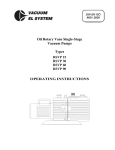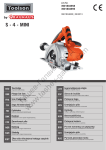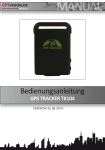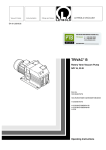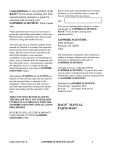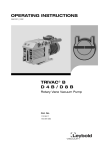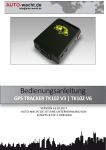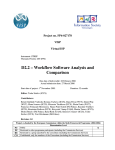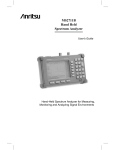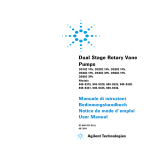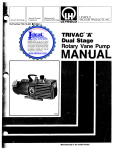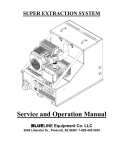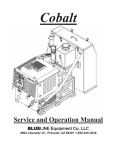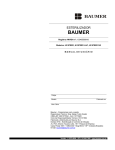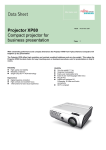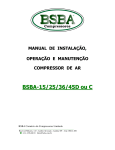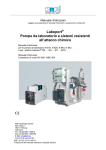Download Operating Instructions
Transcript
Oil Rotary Vane Two-Stage Vacuum Pumps Types RTVP 16 А RTVP 30 A RTVP 60 А RTVP 16 АC RTVP 60 AC RTVP 60 АC OPERATING INSTRUCTIONS Operating Instructions for RTVP C2 1. Description ..................................................................................................................................................4 1.1 Function.................................................................................................................................................5 1.2 Supplied Equipment ..............................................................................................................................6 1.3 Transportation .......................................................................................................................................7 1.4 Technical Data.......................................................................................................................................7 2. Vacuum Safety..........................................................................................................................................10 2.1 Vacuum Pumps / Vacuum System Hazards ........................................................................................10 2.2 Hazardous Overpressure .....................................................................................................................10 2.3 Pump Oil Hazards ...............................................................................................................................10 3. Operation ..................................................................................................................................................11 3.1 Unpacking of The Pump .....................................................................................................................11 3.2 Installation...........................................................................................................................................11 3.3 Connection to the System....................................................................................................................12 3.4 Electrical Connection ..........................................................................................................................12 3.5 Start-up ................................................................................................................................................13 3.5.1 Application Areas........................................................................................................................14 3.6 Operation.............................................................................................................................................14 3.6.1. Pumping of Non-Condensable Gases.........................................................................................14 3.6.2. Pumping of Condensable Gases and Vapours............................................................................14 3.6.3 Operating Temperature ...............................................................................................................15 3.7 Switching Off / Shutdown...................................................................................................................15 3.7.1 Shut-Down ..................................................................................................................................16 3.7.2 Failure of the Control System or the Mains Power .....................................................................16 4. Maintenance..............................................................................................................................................16 4.1 Checking the Oil Level .......................................................................................................................17 4.1.1 Checking the Condition of N 62, HE 200 Oil, Shell Corena V...................................................17 4.2 Oil Change...........................................................................................................................................17 4.3 Cleaning the Dirt Trap.........................................................................................................................18 4.4 Storing the Pump .................................................................................................................................18 4.5 Maintenance plan ................................................................................................................................19 5. Troubleshooting........................................................................................................................................20 6. Repair in Authorized Service ..................................................................................................................21 7. Spare Parts................................................................................................................................................21 8. Warranty Conditions ...............................................................................................................................22 9. Clients Service ..........................................................................................................................................22 Test Report....................................................................................................................................................23 EC Declaration of Conformity ...................................................................................................................24 Declaration of Contamination of Vacuum Pumps ....................................................................................25 10. Spare Parts List ......................................................................................................................................26 www.vacuumsys.com Vacuum El System 2/32 Operating Instructions for RTVP C2 Indications: Warning: Indicates procedures that must be strictly observed to prevent hazards to persons. Caution! Indicates procedures that must strictly be observed to prevent damage to, or destruction of the equipment. --------------------------------------------------------------------------- Caution! We recommend that you carefully read this user’s manual before you begin operation of RTVP vacuum pump. We do not bear responsibility for accidents or damages, caused by or related to product exploitation, occurred due to nonobservance of hereby instructions. Our responsibility constitutes a quality repair service in case of troubleshooting, and is limited within the value of the product. Figures: The references to figures in the text, consist of the figure No and the position No, e.g. (1/3). Service: If a pump is returned to a service, indicate whether the pump is free of substances damaging to health or whether it is contaminated. If it is contaminated also indicate the nature of the hazard. Any pump, sent to a service without a “Declaration of Contamination”, will be returned to the sender’s address, on the account of the sender. Disposal of waste oil Anyone in possession of used oil is responsible for its proper disposal, in accordance with the local acting regulations. Used oils coming from vacuum pumps must not be mixed with other substances. Used oils from vacuum pumps (on the basis of mineral oils) having been affected by normal contamination due to oxygen from the ambient air, increases in temperature and mechanical wear, must be disposed of as used oil in accordance with the regulations. Used oils from vacuum pumps that have been contaminated by other substances must be labelled, stored and disposed of as special waste with reference to the kind of contamination. In many countries proof of where the oil has finally been left is required by Law and often shipping of such contaminated waste requires permission by the authorities. www.vacuumsys.com Vacuum El System 3/32 Operating Instructions for RTVP C2 When storing and disposing of used oil please observe the safety regulations that are valid in your country. 1. Description RTVP pumps are oil-sealed rotary vane two-stage vacuum pumps. The number in the type designation (RTVP 16, 30 and 60) indicates the pumping speed in m3/h, and the marks “A” or “AC” – the variant of designation – normal make (A) and for aggressive media (AC). They are highly productive at comparatively low weight and low energy cost. Application areas are industry, power engineering, electrical engineering, microelectronics, metallurgy, pharmaceutics, optics, sputtering installations and others. RTVP pumps can pump gases and vapours and evacuate vessels or vacuum systems in the fine vacuum range. • Pumps of standard design are not suitable for pumping greater than atmospheric concentrations of oxygen, hazardous gases, or extremely aggressive or corrosive media. RTVP pumps operate through means of three-phase electric motors, having different power, depending on the pumping speed. Caution! • RTVP 16 А and RTVP 16 АC are also available with a single-phase motor. The drive motor is directly flanged to the pump. The pump and motor shafts are directly connected by a flexible coupling. The bearing points of the pump module are force lubricated sliding bearings. All connections are to be found at the top of the pump. The oil-level indicator is provided with a prism for better observation of the oil level. The pump module consists of assembly parts which are pin-fitted so as to allow easy disassembly and reassembly. www.vacuumsys.com Vacuum El System 4/32 Operating Instructions for RTVP C2 Fig.1. Sectional drawing of RTVP 1 Coupling housing 2 Coupling 3 Centrifugal switch 4 Exhaust port 5 Front-end plate 6 Rotor 7 Intermediate plate 8 Rotor Shaft 9 Oil reservoir 10 Rotor 11 Electrical motor 12 Oil-drain plug 13 Low-vacuum ring 14 High-vacuum ring 15 Oil-sight gauge 16 Anti-suckback valve 17 Dust trap filter 18 Intake port 19 Gas ballast valve – knob 20 Valve plate 21 Gas ballast valve 22 Demister 23 Exhaust valve 24 Oil nozzle 25 Vanes 1.1 Function In accordance with Fig.1, the rotor (1/10), mounted eccentrically in the high vacuum ring (1/14), has three radially sliding vanes (1/25) which divide the high-vacuum stage of the pump chamber into several compartments. The volume of each compartment changes periodically with the rotation of the rotor. As a result, gas is sucked in at the intake port (1/18). The gas passes through the dust trap filter (1/17), flows past the open anti-suckback valve (1/16) and then enters the pump chamber. In the pump chamber, the gas is passed on and compressed.The oil injected into the pump chamber is used for sealing and lubricating. The compressed gas passes through intermediate plate (1/7), in the chamber of the low-vacuum stage, consisting of a rotor (1/6) and a low-vacuum ring (1/13). The operating principle of the two stages is identical. From the chamber of the low-vacuum stage, the compressed gas enters the pump oil reservoir, when certain pressure through the exhaust valve (1/23) has been obtained. The oil entrained in the gas is coarsely trapped in the internal demister (1/22); there the oil is also freed of mechanical impurities. The gas leaves the pump through the exhaust port (1/4). During compression, a controlled amount of air – the so called gas ballast – can be allowed to enter the pump chamber by opening the gas ballast valve (1/21). The gas ballast stops condensation of vapours in the pump chamber up to the limit of the water vapour tolerance. The gas ballast valve is opened and closed by turning the gas ballast knob (1/19). The oil is separated from the gas in the pump in two steps (phases). First, small droplets are coalesced into large drops. Then, the large drops fall into the oil reservoir as the exhaust gas is diverted by the inner walls of the oil case. Thus a low loss of oil is obtained. This and the large usable oil reservoir ensure long intervals between oil changes even at high intake pressures. The vacuum in the operating media is maintained by an anti-suckback valve (1/16) which is controlled via the centrifugal switch (1/3). During operation of the pump the control piston and the valve disc of the anti-suckback valve are held at the lower position by their own weight (valve open). www.vacuumsys.com Vacuum El System 5/32 Operating Instructions for RTVP C2 When the pump stops (because it has been switched off or because of a failure), the air pressure pushes the control piston up. Thus a connection is provided between the pump chamber, the oil reservoir and the piston of the antisuckback valve. Air follows in, which vents the pump chamber and forces the valve disc (1/16) against its seat. This effectively prevents backstreaming of oil or oil vapours. The anti-suckback valve (1/16) operates independently of the operating mode of the pump, i.e. also with gas ballast. 1.2 Supplied Equipment Standard equipment supplied includes: Pump with motor, including initial filling of N 62 , HE200 or Shell Corena V oil, A set of connecting elements DN 25 KF or DN 40 KF, depending on the concrete pump, 1 centering “O”ring, 1 centering “O”ring with dirt trap, 2 clamping rings. For protection during shipment, the connection ports are each wrapped separately and placed in the pump package. Switches, motor protection switch, mains cable etc. are not included. www.vacuumsys.com Vacuum El System 6/32 Operating Instructions for RTVP C2 1.3 Transportation • Pumps which are filled with operating oil must only be moved while standing in normal /operating/ position. Otherwise oil may escape. Avoid any other orientations during transport. Acceptable tilt degree - 15°. Caution! • Check the pump for the presence of any oil leaks, since there exists the danger that someone may slip on spilt oil. • When lifting the pump you must make use of the crane eyes provided on the pump for this purpose; also use the recommended type of lifting device. 1.4 Technical Data Model Description Free Air Pumping * Pumping Speed ** Ultimate remaining pressure *** - Gas-ballast – closed - Gas-ballast – open Ultimate working pressure **** - Gas-ballast – closed - Gas-ballast - open Measure RTVP 16A RTVP 16AC RTVP 30 А RTVP 30 АC RTVP 60 А RTVP 60 АC m3/h m3/h 20 16 38 30 76 60 mbar mbar 2,5x10-4 6,5 x10-3 2,5x10-4 6,5 x10-3 2,5x10-4 6,5 x10-3 mbar mbar ≤ 4x10-4 ≤ 6,5 x10-3 220V 1-PH 220V/380V 3-PH 0.55 1500 58 1,3 N62 12~40 NW 25/ NW 25 550(L) x 172(W) x 290(H) 30 ≤ 4x10-4 ≤ 6,5 x10-3 ≤ 4x10-4 ≤ 6,5 x10-3 220V/380V 3-PH 220V/380V 3-PH 1.1 1500 60 3,4 N62 12~40 NW 40/ NW 40 615(L) x 242(W) x 365(H) 73 2.2 1500 66 4,1 N62 12~40 NW 40/ NW 40 730(L) x 242(W) x 365(H) 90 Incoming voltage (50Hz) Electric motor power Nominal speed, rpm Noise level Quantity of oil Recommended oil Tolerance of ambient temperature Input / Output type kW min-1 DB(A) l °С Dimensions mm Weight kg * Theoretical pumping speed. ** Pumping speed in working media, measured at specific laboratory conditions – gas, pressure, temperature, etc. This speed is variable, depending on the real operation process. *** Lowest values of pressure (with/without gas ballast), which can be obtained at specific laboratory conditions. **** Operational pressure values (with/without gas ballast), obtainable in real conditions, in accordance with the pump operation instructions. All measurements of vacuum pumps parameters are done in compliance with the factory instructions. www.vacuumsys.com Vacuum El System 7/32 Operating Instructions for RTVP Fig.3 – Pumping speed characteristics of RTVP vacuum pumps www.vacuumsys.com Vacuum El System 8/32 C2 Operating Instructions for RTVP Fig. 4 – Dimensions of RTVP 16 A / RTVP16 AC Fig. 5 –Dimensions of RTVP 30 A/ RTVP 30 AC Fig. 6 – Dimensions of RTVP 60 A / RTVP 60 AC www.vacuumsys.com Vacuum El System 9/32 C2 Operating Instructions for RTVP C2 2. Vacuum Safety 2.1 Vacuum Pumps / Vacuum System Hazards Consider all possible chemical reactions within your system. Make allowance for abnormal chemical reactions, including those, which could occur under fault conditions. Refer to material data sheets when you assess the potential hazards, associated with your process materials. Use dilution techniques to minimize reactions with oxidants and flammable materials. Use manufacturers recommendations for type of lubricant in your pump when you pump oxidants and pyrophoric materials. When you perform safety calculations, ensure that the safe working pressure for all components in the system are taken into account. Ensure that you incorporate the correct type of pressure relief devices and that they are suitably rated for your application. If you pump hazardous materials, you must design the system to fail to a safe condition. Leak test systems and equipment before use. No part of the body should be exposed to vacuum. The exposure of small areas of the body surface to the suction of a pumping system can result in tissue damage. Exhaust hazard – Any dangerous gas substances that may be present in the system being evacuated may pass through the system into the pump and be emitted at the exhaust. Suitable precautions must be taken. 2.2 Hazardous Overpressure Hazardous pressures may be produced if the exhaust from an automatic pump is restricted or blocked, and care should be taken at all time to prevent this. Exhaust line manifold systems should be designed to cope with the maximum exhaust load that can occur. Hazardous pressures may be produced in the system to be evacuated if the rotary pump is operated in the reverse sense. When a rotary pump motor requires a three-phase electrical supply, the outfit should be checked for correct rotation after main connection, before being connected to the system to be evacuated. 2.3 Pump Oil Hazards Cleaning hazard – Suitable precautions should be taken to protect personnel, engaged in cleaning vacuum pumps from the solvents being used and from the process debris in the pump. The exact precautions to be taken will be dependent on the cleaning solvent involved and the applied process, but particular attention should be paid to the danger of inhaling solvent vapours. Oil mist hazard – Rotary pumps are oil-sealed and discharge small quantities of oil mist when operating. In poorly ventilated areas this can lead to unacceptable concentrations of oil-vapour. Oil vapour should be kept to a minimum. It is recommended that a suitable oil mist filter is fitted to the pump or, alternatively, the exhaust should be piped away externally. Oils, based on mineral products are only slightly to moderately irritating to the skin and eyes. Prolonged exposure of the skin to mineral oils may give rise to dermatitis. www.vacuumsys.com Vacuum El System 10/32 Operating Instructions for RTVP C2 Care should, however, be taken to avoid inhalation of vapours or mists, arising from undue heating or excessive mist generation. In the case of fluorinated compounds (e.g. Fomblin), avoid contact with excessive heat (280o C), e.g. lighted cigarettes, heater elements, etc. Oil fluid spillage should be absorbed with sand, earth or mineral absorbent and disposed of in the proper manner. In the event of large spillage, steps should be taken to prevent possible pollutions. The operating temperature of the vacuum oils should be in the order of safe operating conditions in a vacuum environment. A hazardous condition may occur if the oil is permitted to overheat excessively (self-ignition, chemical decomposition and emission of dangerous components, etc.). 3. Operation 3.1 Unpacking of The Pump Once the pump has been taken out of the cardboard box, in order to operate you must: • • Dismantle the metal frame, by unscrewing 6 pieces of М8 nuts, key No 13. Dismantle the pump from the wooden panel, by unscrewing 4 pieces of М8 nuts, key No 13. When lifting and/or moving the pump you must make use of the crane eyes provided on the pump for this purpose; also use the recommended type of lifting device. 3.2 Installation • The standard pump is not suited for installation in explosion hazard areas. When planning such an application please contact us first. The pump must be set up on a flat, horizontal surface. The ambient temperature should not exceed +40 °C and not drop below +12 °C. The site chosen should allow adequate air circulation to cool the pump. Caution! www.vacuumsys.com • If you wish to firmly install the pump in place, insert bolts or similar connecting elements through the bore holes in the feet. Use rubber feets to act as vibration absorbers. RTVP 16A and RTVP 16 AC are equipped with rubber feet. • When installing RTVP pump, make sure that the connections and controls are readily accessible. • Max. tilt allowed, for the pump with possibly fitted standard accessories is 5° from the vertical. The site chosen should allow adequate air circulation to cool the pump. • If the pump is installed on a tilt surface, the indicated oil level will be altered, and this has to be taken into consideration. Vacuum El System 11/32 Operating Instructions for RTVP C2 3.3 Connection to the System Before connecting the pump, remove the shipping seals from the exhaust (1/4) and the intake (1/18) flanges. Caution! • Retain the shipping seals in case you need to store the pump in the future. Connect the intake and exhaust pipes, using centering ring, “O” ring and a clamp for each ring. Placing of a filter at the intake pipe is recommendable. Caution! • The intake line must be clean. Deposits in the intake line may outgas and adversely affect the vacuum. The connecting flanges must be clean and undamaged. • The cross-section of the intake and exhaust lines should be at least the same size as the connection ports of the pump. If the intake line is too narrow, it reduces the pumping speed. If the exhaust line is too narrow, overpressures may occur in the pump; this might damage the shaft seals and cause oil leaks. The maximum pressure in the oil case must not exceed 1.5 bar. When pumping oil vapours, it is advisable to install filters /condensate traps/ on the exhaust side. Install the exhaust line with a downward slope (lower than the pump) so as to prevent condensate from flowing back into the pump. If this is not possible, insert a condensate trap. In order to reduce the emission of oil vapours we recommend the installation of an additional exhaust filter. • Never operate the pump with a sealed exhaust line. There is the danger of injury. • Before starting any work on the pump, the personnel must be informed about possible dangers first. All safety regulations must be observed. 3.4 Electrical Connection • Before beginning with any work on the wiring, ensure that mains supply for the pump is off. • Electrical connections must be done by a qualified electrician in accordance with the acting guidelines. RTVP pumps are supplied without accessories for electrical connection. They must be connected via the appropriate cable, and a suitable motor protection switch. Set the switch in accordance with the rating on the motor nameplate. www.vacuumsys.com Vacuum El System 12/32 Operating Instructions for RTVP C2 Fig. 7 Connection diagram for a 3-phase motor. • The pump is connected through a 4-wire cable, three wires are for the phase leads (R, S, and T) and the fourth is the Neutral lead, connected to the bolt, marked with sign Fig. 8 Connection diagram of a single-phase motor. • • Refers only to RTVP 16 А and RTVP 16 АC pumps with a single-phase motor. The pump is connected through a 3-wire cable, two leads are connected to the terminals of the box, and the third – protective lead is connected to the bolt, marked with sign Caution! • After connecting the motor and after every time you alter the wiring, check the direction of rotation. To do so, briefly switch on the motor and check whether a suitable cover (e. g. a blank flange) is sucked on at the intake port. If not, interchange the two phase leads of the connection. Observe the direction arrow on the coupling housing! • Each time before starting up check the oil level. 3.5 Start-up Caution! For pumps with 3-phase motors, check the direction of rotation before starting the pump for the first time and after each change in the electrical connection. On initial start-up, after prolonged idle periods or after an oil change, the specified ultimate pressure cannot be attained until the oil is degassed. This can be done by running the pump for approx. 30 min. with the intake line closed and the gas ballast valve (1/21) open. www.vacuumsys.com Vacuum El System 13/32 Operating Instructions for RTVP C2 • Before starting the pump ensure that the pump and the fitted accessories meet the requirements of your application and that safe operation can be guaranteed. • Avoid exposure of any part of the body to the vacuum. There is the danger of injury. Never operate the pump with an open intake port. Vacuum connections as well as oilfill and oil-drain openings must never be opened during operation. • The safety regulations which apply to the application in each case must be observed. This applies to installation, operation and during maintenance (service) as well as waste disposal and transportation. • The standard pumps are not suited for pumping of hazardous gases or vapours. 3.5.1 Application Areas Caution! • The pump is not suitable for pumping of: ignitable and explosive gases or vapours oxidants pyrophorous gases. • The pumps are not suitable for pumping of liquids or very dusty media. Suitable protective devices must be installed. 3.6 Operation RTVP pumps can pump condensable gases and vapours within the acceptable tolerance, provided that the gas ballast valve (1/21) is open and the pump has attained its operating temperature. 3.6.1. Pumping of Non-Condensable Gases If the process contains mainly permanent gases, the pump may be operated without gas ballast, provided that the saturation vapour pressure at operating temperature is not exceeded during compression. If the composition of the gases to be pumped is not known and if condensation in the pump cannot be ruled out, run the pump with the gas ballast valve open. 3.6.2. Pumping of Condensable Gases and Vapours With the gas ballast valve open and at operating temperature, RTVP pumps can pump pure water vapour up to the water vapour tolerance. If the vapour pressure increases above the permissible level, the water vapour will condense in the oil of the pump. Caution! • During pumping, vapours may dissolve in the oil. This changes the oil properties and thus there is a risk of corrosion in the pump. Therefore, don’t switch off the pump immediately after completion of the process. Instead, allow the pump to continue operating with the gas ballast valve open and the intake line closed until the oil is free of condensed vapours. We strongly recommend operating the pump in this mode for about 30 minutes after completion of the process. www.vacuumsys.com Vacuum El System 14/32 Operating Instructions for RTVP C2 In cyclic operation, the RTVP pumps should not be switched off during the intervals between the individual working phases (power consumption is minimal when the pump is operating at ultimate pressure), but should continue to run with gas ballast valve open and intake port closed (if possible via a valve). Once all vapours have been pumped off from a process (e.g. during drying), the gas ballast valve can be closed to improve the attainable ultimate pressure. 3.6.3 Operating Temperature Proper operation of the RTVP is ensured in the ambient temperature range between 12 °C to 40 °C. • At normal operation, the surface temperature of the oil case may exceed 80 °C, depending on the load. • There is the danger of receiving burns. 3.7 Switching Off / Shutdown Under normal circumstances, all that you need do is to electrically switch off the pump. No further measures will be required. Caution! • When pumping condensable media let the pump continue to operate with the gas ballast valve open and the intake line closed before switching off. • When pumping aggressive or corrosive media, let the pump continue to operate even during long non-working intervals (e.g. overnight) with the intake line closed and the gas ballast valve open. This avoids corrosion during idle periods. If the pump is to be shutdown for an extended period after pumping aggressive or corrosive media or if the pump has to be stored, proceed as follows: • . When pumping harmful substances, take adequate safety precautions: Drain the oil. Add clean oil until the oil-level is at the “min” mark and let the pump operate for some time. Then drain the oil and add clean oil until the oil level is at the “max.” mark (as shown in Fig.9). Seal the connection ports. Special conservation or anticorrosion oils aren’t necessary. Caution! www.vacuumsys.com • Please also take note of the information given in Section 4.4 (storage and storage conditions). Vacuum El System 15/32 Operating Instructions for RTVP C2 3.7.1 Shut-Down Through Monitoring Components • When the pump has been switched off due to overheating sensed by the motor coil protector, the pump must only be started manually after the pump has cooled down to the ambient temperature and after having removed the cause first. 3.7.2 Failure of the Control System or the Mains Power • In order to prevent the pump from running up unexpectedly after a mains power failure, the pump must be integrated in the control system in such a way that the pump can only be switched on again manually. 4. Maintenance • Disconnect the electrical connections before disassembling the pump. Make absolutely sure that the pump cannot be accidentally started. • If the pump has pumped harmful substances, ascertain the nature of hazard and take adequate safety measures. Observe all safety regulations. If you send a pump for repair please observe the information provided in Section 6. • When disposing of used oil, you must observe the applicable environmental regulations! Due to the design concept, RTVP pumps require very little maintenance when operated under normal conditions. The work required is described in the sections below. Caution! www.vacuumsys.com • All work must be carried out by suitably trained personnel. Maintenance or repairs carried out incorrectly will affect the life and performance of the pump and may cause problems when filing warranty claims. • If the pump has been used in ambient air which is much contaminated, make sure that the air circulation and the gas ballast valve are not adversely affected. • When the RTVP has been pumping corrosive media we recommend that possibly planned maintenance work be carried out immediately in order to prevent corrosion of the pump while it is at standstill. Vacuum El System 16/32 Operating Instructions for RTVP C2 4.1 Checking the Oil Level During operation of the RTVP the oil level must always remain between the marks “min” and “max” at the oil-level glass. The amount of oil must be checked and topped up as required. Fig. 9 An oil-level indicator scheme, RTVP pumps Caution! • Fill in oil only after the pump has been switched off. 4.1.1 Checking the Condition of N 62, HE 200 Oil, Shell Corena V a) Visual check Normally the oil is clear and transparent. If the oil darkens, it should be changed. b) Chemical check The neutralisation number of the oil is determined according to DIN 51558. If it exceeds 2, the oil should be changed. c) Viscosity check If the viscosity of N 62 oil at 25 °C exceeds 300 mPas, the oil should be changed. If gases or liquids dissolved in the oil result in a deterioration of the ultimate pressure, the oil can be degassed by allowing the pump to run for approx. 30 min. with the intake port closed and the gas ballast valve open. When wanting to check the oil, switch off the pump first and drain out from the warm pump the required amount of oil from the oil drain plug (1/12) into a beaker or similar. 4.2 Oil Change For proper operation of the pump, it is essential that the pump has an adequate supply of the correct and clean oil at all times. The oil must be changed when it looks dirty or if it appears chemically or mechanically worn out. The oil should be changed at every 2,000 operating hours or after one year. At high intake pressures and intake temperatures and/or when pumping condensable gases or vapours, the oil will have to be changed more frequently. Further oil changes should be made before and after long-term storage of the pump. If the oil becomes contaminated too quickly, install a dust filter and/or oil filter. Required tool: Allen key size 8. www.vacuumsys.com Vacuum El System 17/32 Operating Instructions for RTVP Caution! C2 • Only change the oil after the pump has been switched off and while the pump is still warm. • If there is the danger that the operating agent may present a hazard because of the media, which have been pumped, you must ensure that all necessary safety precautions are taken. Remove the oil-drain plug and let the used oil drain into a suitable container. When the flow of oil slows down, screw the oil-drain plug back in, briefly switch on the pump (max. 10 s) and then switch it off again. Remove the oil-drain plug once more and drain out the remaining oil. Screw the oil-drain plug back in (check the gasket and reinstall a new one if necessary). Remove the oil-fill plug and fill in with fresh oil. Screw the oil-fill plug back in. The quantity of oil, needed for your pump model, can be checked at the Technical Specifications (section 1.4) 4.3 Cleaning the Dirt Trap A wire-mesh sieve is located in the intake port of the pump to act as a dirt trap for coarse particles. It should be kept clean. For this purpose, remove the dirt trap from the intake port and rinse it in a suitable vessel with solvent. If the dirt trap is defective, replace it with a new one. Caution! • The cleaning intervals depend on the application. If the pump is exposed to large amounts of abrasive materials, a dust filter should be fitted into the intake line. 4.4 Storing the Pump • The pump should be stored in a dry place preferably within the operating temperature (12 °C - 40 °C). Before the pump is shelved it must be properly disconnected from the vacuum system, purged with dry nitrogen and the oil should be changed too. The inlets and outlets of the pump must be sealed with the shipping seals, which are provided upon delivery. • The gas ballast switch must be set to the “closed” position. Caution! When a pump is put into operation after it has been shelved for over one year, standard maintenance should be run on the pump and the oil should also be exchanged (see “Operation” and “Maintenance”). www.vacuumsys.com Vacuum El System 18/32 Operating Instructions for RTVP C2 4.5 Maintenance plan • Maintenance before switching on the system Check the oil level, change the oil if required. Oil: N 62 or special and alternative oils. Refill: only after the pump has been switched off. Check the quality of the oil, change the oil if required. Visually: normally light and transparent, oil change is required when discolorations increase. • Daily maintenance Operate the pump for at least 30 minutes with gas ballast. Condensed water is thus removed from the oil. Check the oil level, change the oil if required. Oil: N 62 or special and alternative oils. Refill: only after the pump has been switched off. Check the quality of the oil, change the oil if required. Visually: normally light and transparent, oil change is required when discolorations increase. • 6 monthly maintenance Check the oil level, change the oil if required: Chemically: according to DIN-51558; Mechanically: when dynamic viscosity at 25 °C exceeds 300 mPas; then an oil change will be required. Clean the dirt trap in the intake port, change it as required. Use suitable cleaning agent and compressed air. Observe the safety regulations when using cleaning agents. Service Maintenance of the Pump This kind of maintenance is done only in the service, specified in the Warranty Card! • Annual maintenance ( at the client’s premises ) Check of the teeth edges on the coupling element for any damages; Oil change; Cleaning of the oil level glass; Checking of the fan of the pump and the motor as well as the cooling fins on the motor for deposits Measurement of pump parameters; • Maintenance at every two years ( in service ) Complete disassembly and cleaning of the pump components; Checking of the individual components; Oil change; Change of all gaskets and seals; Visual check and measurement of the vanes; Measurement of pump parameters and functional check; www.vacuumsys.com Vacuum El System 19/32 Operating Instructions for RTVP C2 5. Troubleshooting Fault Pump does not start Possible cause Wiring is malfunctioning. Motor protection switch incorrectly set (3-phase motors only). Operating voltage does not match motor. Remedy Check and repair wiring. Set motor protection switch properly. Section* 3.4 Replace the fault element. service Motor is malfunctioning. Oil temperature is below 12 °C. Oil is too viscous. Replace the motor. Heat the pump and pump oil or use different oil. Change the oil. service 3.6.3/4.2 4.2 Measuring technique or gauge is unsuitable. External leak ** Exhaust valve is malfunctioning. Oil is unsuitable. Intake line is dirty. Pump is too small. Use correct measuring technique and gauge. service Repair the pump. Repair the valve. Change the oil (degas it, if necessary). Clean vacuum lines. Check the process data; replace the pump, if necessary. service service 4.2 - Pumping speed is too low Dirt trap in the intake port is clogged. Exhaust filter is clogged. Connecting lines are too narrow or too long. Clean the dirt trap; Exchange the filter element. Use adequately wide and short connecting lines. 4.3 3.3 After switching off pump under vacuum, pressure in system rises too fast. System has a leak. Anti-suckback valve is malfunctioning. Check the system. Repair the valve. service Pump gets hotter than usually observed. Cooling air supply is obstructed. Ambient temperature is too high. Process gas is too hot. Oil cycle is obstructed. Exhaust filter or exhaust line is obstructed. Exhaust valve is malfunctioning. Pump module is worn out. Set pump up correctly. 3.2 Set the vacuum system correctly. Clean or repair the oil lines and channels. Replace the exhaust filter, clean the exhaust line. 4.2 service - Repair the valve. Replace the pump module. service service Oil in the intake line or in vacuum vessel. Oil comes from the vacuum system. Anti-suckback valve is damaged. Sealing surfaces of anti-suckback valve are damaged or dirty. Check the vacuum system. Clean or repair the valve. Clean or repair the intake port and the anti-suckback valve. service service Oil is turbid. Condensation. Degas the oil or change the oil and clean the pump. 2.5.2/4.2 Pump is excessively noisy. Oil level is much too low (oil is no longer visible). Intake pressure is too high. Coupling element is worn. Vanes or bearings are damaged. Add oil. 4.2 Lower the intake pressure. Install new coupling element. Repair pump. 3.6 service Oil-leak from the vacuum pump. Pump works too long at high intake pressure. Repair the leak. Install an oil-trap at the exhaust line and/or optimize the vacuum system. - Pump does not reach ultimate pressure Oil-level falls too fast * Repair information: refer to the Section in the Operation Instruction stated here. ** Bubble test: the warm pump with degassed oil is running without gas ballast and the intake blanked off. The exhaust line is led in to a vessel with water. If an evenly spaced line of bubbles appears, then the pump has an external leak. www.vacuumsys.com Vacuum El System 20/32 Operating Instructions for RTVP C2 6. Repair in Authorized Service When you have purchased a pump, you have also received a Warranty Card, completed and sealed by the Seller. It indicates the corresponding service, which will be serving your pump in case of warranty defects and maintenance, in accordance with the plan in section 4.5. If a pump is returned to a service for maintenance, indicate whether the pump is free of substances damaging to health or whether it is contaminated. If it is contaminated also indicate the nature of the hazard. For this you must use a form which has been prepared by us. Please make a copy and fill in the form - “Declaration of Contamination of Vacuum Pumps”. This “Declaration of Contamination” is required for the protection of our personnel. Any pump, sent to a service without a “Declaration of Contamination” will be returned to the sender’s address, on his account. • The pump must be packed in such a way, that it will not be damaged during shipping and so that any contaminants are not released from the package. 7. Spare Parts In order to ensure normal operation of the vacuum pump and to avoid any hazards, relating to its exploitation, the manufacturer recommends repair of the pump and replacement of spare parts in an authorized service only. The authorized services have all necessary spare parts on stock and are in position to provide fast and competent assistance for the service of the product. • www.vacuumsys.com In case a repair or a service maintenance is needed, please observe the instructions for transportation, maintenance and repair, pointed in sections 1.3, 4.5 and 6. Vacuum El System 21/32 Operating Instructions for RTVP C2 8. Warranty Conditions We – “Vacuum El System” Ltd., herewith declare that the hereby product is made of quality materials and guarantee normal pump operation, provided that all instructions in the hereby User’s Guide are observed. Warranty period is 24 months from date of purchase. Change of mechanical elements, including but not limited with oil, shaft seals, filters and others, made with concern to normal service maintenance, are not subject of this warranty. This warranty will be void in case of pumps, damaged by improper transportation or non-observance of instructions for operations and storage (e.g. operated at high ambient temperature, polluted media, corrosive or explosive liquids and gases) as well as in cases, when an attempt from third persons or companies has been made to repair the malfunction. Limitation of liabilities: Liabilities are limited to repair and renovation or replacement of the pump, at the choice of “Vacuum El System”. 9. Clients Service Each time, when you address us, in order to get service, maintenance or advise, please provide information about the model, the pump serial number and the date of purchase. Please, refer to the seller’s invoice or the information plate, attached to the pump. www.vacuumsys.com Vacuum El System 22/32 Operating Instructions for RTVP Test Report No …………… 1. Product: ID No: Name: 2. Technical parameters: Parameter Ultimate operational pressure without gasballast Ultimate operational pressure with gasballast Measure Requirement mbar ≤ 4х10-4 mbar ≤ 6,5 . 10-3 Pump operational temperature 0 C ≤ 80 At ambient temperature 0 C 12 ~ 40 Test technician: ….. ……………………….. Metrologist: ……………………….. /St. Stoilov/ www.vacuumsys.com Measured /T. Hristov/ Vacuum El System 23/32 C2 24/32 Operating Instructions for RTVP C2 Declaration of Contamination of Vacuum Pumps The repair and/or service of vacuum pumps will only be carried out if a correctly completed declaration has been submitted. The manufacturer or the authorized service has the right to refuse to accept any pump without a declaration. This declaration can only be completed and signed by authorized personnel. Vacuum pumps, which have been contaminated by biologically active or explosive substances, will not be accepted without written evidence of decontamination. 1. Description of the vacuum pump: - model / type: - serial No: - invoice No: 2. Reason for return of the vacuum pump: _______________________________________________________________________________________________ _______________________________________________________________________________________________ _______________________________________________________________________________________________ 3. Condition of the vacuum pump: - has the pump been used? yes no - what type of pump oil/liquid has been used? __________________________________ - is the pump free from potentially harmful substances? yes (go to Section 5) no (go to Section 4) 4. Process related contamination of vacuum pump: - toxic - corrosive - explosive - biological hazard - radioactive - other harmful substances yes yes yes yes yes yes no no no no no no Please, list all substances, gases and by-products, which may have come into contact with the pump. Trade name, Product name, Manufacturer 1. 2. 3. 4. Chemical name (or symbol) Dangerous class material Measures if spillage First aid in case of human contact 5. Declaration Undersigned _______________________________________________ hereby declare that the information supplied on this form is complete and accurate. The dispatch of the contaminated vacuum pump will be in accordance with the appropriate regulations covering packaging, transportation and labeling of dangerous substances. Name of organization or company: __________________________________________________________________ Address: __________________________________________________________; Post code: ___________________ Tel.: ______________________________________________________; Fax: _______________________________ Name: ________________________________________________________________________________________ Job title: _______________________________________________________________________________________ Date: __________________ www.vacuumsys.com Legally binding signature: _______________________ (company stamp) Vacuum El System 25/32 Operating Instructions for RTVP 10. Spare Parts List Fig.2. Detailed scheme of RTVP vacuum pump www.vacuumsys.com Vacuum El System 26/32 C2 27/32 1 1 1 2 1 1 1 1 2 2 1 1 1 1 4 5 5 6 6 7 7 7a 7a 8 9 10 11 11 12 12 12 13 13 14 15 801134 801241 801250 800766 800767 802013 802017 802367 802369 801477 801133 801448 800103 800102 800113 800112 800111 801135 801136 800133 800565 2 4 15 b 16 16 17 801299 801303 800602 800558 1 1 15 a 801137 1 1 1 2 2 1 1 1 1 2 1 2 4 801127 2 3 802369 2 1 2 2 1 1 3 2 800685 1 30 А 802367 1 16 А Pump Model 800684 1 800778 Pos. 800779 Cat. No. VES 2 2 1 1 1 1 1 1 2 2 1 1 1 1 2 2 1 1 60 А INTAKE TUBE GAS BALLAST VALVE STEM BASE RUBBER FOOT SEAL" SEAL" OIL LEVEL GLASS HANDLE SEAL" SEAL" OIL CASING OIL CASING OIL CASING COUPLING HOUSING COUPLING HOUSING EYE BOLT PLUG GASKET" PLUG SCREW" O-RING" O-RING" CENTERING RING CENTERING RING EXHAUST PORT EXHAUST PORT O-RING" O-RING" FLAT GASKET" FLAT GASKET" O-RING" O-RING" FILTER (Dirt trap-mesch) FILTER INTAKE TUBE Description 351 67 206 461 75 107 279 80 308 520 40 125 .3 520 40 125 .2 520 40 125 283 02 107 238 11 142 238 11 126 333 72 128 333 72 123 330 72 124 333 58 116 331 55 139 201 13 101 239 55 165 201 27 105 239 70 516 239 70 506 231 94 207 231 94 206 433 60 117 433 60 115 239 70 304 239 70 117 238 20 158 238 20 156 239 70 516 239 70 506 411 70 206 411 70 121 433 60 119 431 65 116 Cat.№ Leybold Dimension 60 x 40 D 20 x 16 D 43 x 50 x 2 D 68 x 60 x 2 106 x 120 x 32 242 x 270 x 1 172 x 190 x 1 200,5x172,5x192,5 246.5x242x279.5 321.5x242x279.5 265x172,5x216,5 164x242x272.5 Al-aly, St Steel NBR Viton Viton C Al - aly Thermolit Thermolit C Al - aly C Al - aly C Al - aly C Al - aly Cast iron Steel Viton D 22 х 15,1 х 2 M8 Steel Viton Viton D 16 x 1,5 D 42 x 5 D 28 x 5 Al Al KF 40 Al - aly KF 25 Al - aly Viton Viton AFM AFM Viton Viton Steel Steel Al - aly Al - aly Material KF 25 x 42 KF 40 x 63 D 45 x 3 D 29 x 3 D 75 x 84 D 55 x 63 D 42 x 5 D 28 x 5 KF 25 KF 40 KF 25 x 70 KF 40 x 107 Spare Parts List of RTVP pump models *Not suply separately Notes 28/32 COVER RETAINING RING 1 1 1 1 1 1 1 1 1 1 21 22 23 23 24 24 25 25 26 27 28 29 30 31 31 800711 800701 801225 801255 801402 801400 801139 801138 801425 801401 801130 800702 801433 801142 800662 34 35 35 801125 34 800740 800742 33b 800202 801126 33b 800203 1 1 1 33a 800200 33a 33 33b 33 802516 802515 800204 1 33 802517 800201 1 32 32 801302 801300 1 1 1 1 1 20 801237 1 1 1 1 1 1 1 1 1 1 1 1 1 19 1 1 1 1 1 1 1 1 1 1 1 1 1 1 1 1 1 CENTRIFUGAL SWITCH CENTRIFUGAL SWITCH KEY (COUPLING) KEY (COUPLING) COUPLING ELEMENT (motor side) COUPLING ELEMENT (motor side) COUPLING ELEMENT (motor side) COUPLING ELEMENT (pump side) COUPLING ELEMENT (pump side) COUPLING COMPLETE(pos 32& pos.33) COUPLING COMPLETE COUPLING COMPLETE COUPLING ELEMENT" COUPLING ELEMENT" OIL SEPARATOR OIL FILTER VALVE PLATE (gas ballast)" SPRING (GAS BALLAST)^ RETAINING RING FLAT CASKET" FLAT CASKET (gas ballast)" SPRING (FILTER) SPRING (FILTER) O-RING" O-RING" STIFFENING DISK RETAINING WASHER O-RING" VALVE gas ballast(Assy) CAP 801132 GAS BALLAST VALVE STEM 1 1 1 1 Description 1 60 А 18 30 А 17 16 А 801109 Pos. Pump Model 800555 Cat. No. VES 500 36 147 500 36 128 221 16 179 221 16 151 570 42 129 570 42 113 570 42 112 570 42 129.4 570 42 113-3 411 12 108 390 26 117 231 03 106 341 01 109 401 64 117 221 62 140 231 04 104 239 25 226 239 25 225 221 62 143 221 62 142 239 70 148 239 70 147 222 04 107 221 49 207 239 70 436 350 20 158 349 75 105 351 67 207 Cat.№ Leybold Dimension D 60 x 26 D 70 x 27 6 x 6 x 22 5 x 5 x 18 D 58 x 61 D 82 x 83 D 82 x 83 D 50 x 15 D 75 x 20 D 60 x 90 D 42 x 55 17 x 1 D 46 x 1,5 D 14,8 x 0,2 D 15 x 11,5 15 x 1 D 30 x 16 x 1 D 30 x 18 x 1 D 20 x 35 D 25,2 x 38 D5x2 D 16 x 2,5 D 40 x 0,5 D 19,5 x 33 x 0,9 D 27 x 2,5 D 31,7 x 6 D 50 x 40 Spare Parts List of RTVP pump models Brs,Steel Brs,Steel Steel Steel Cast iron Cast iron Cast iron Cast iron Cast iron Cast iron/Buna Cast iron/Buna Cast iron/Buna Buna Buna Stainless steel Stainless steel Steel Al Steel Steel Steel Viton Viton Steel Steel Viton Viton Brass Steel Viton Termoplast NBR Al-aly, St Material не са в/у фиг.1 не са в/у фиг.1 Notes 29/32 1 2 1 1 1 1 37 38 39 40 40 800589 801399 801140 800165 800168 4 42 42 43 43 44 44 44 44а 44а 801288 800191 800190 801258 801222 802510 802511 802512 800508 800509 1 1 46 46 46 47 47 48 48 49 801117 801120 801121 801116 801115 800149 800150 801146 1 1 46 801119 3 45 45 1 1 1 1 3 3 1 1 1 1 3 44b 800640 801147 1 801148 1 1 44а 44b 1 4 1 2 1 1 800627 1 1 4 1 1 1 1 3 60 А 800510 1 1 1 1 41 41 801291 2 1 37 800588 1 3 1 36 30 А 36 16 А 801426 Pos. Pump Model 801421 Cat. No. VES VANE^ INTERMEDIATE PLATE INTERMEDIATE PLATE(Center bearing) VALVE STOP VALVE STOP VALVE PLATE (corrosive)" VALVE PLATE (corrosive)" VALVE PLATE (normal)" VALVE PLATE (normal)^ VANE VANE^ ROTOR (2nd stage) W/Oshaft ROTOR (2nd stage)W/Oshaft SHAFT (2nd stage) SHAFT(2nd stage) SHAFT (2nd stage) ROTOR WITH SHAFT ROTOR WITH SHAFT ROTOR(2ND STAGE) WITH SHAFT O-RING" O-RING" SECOND STAGE PUMP CYLINDER SECOND STAGE PUMP CYLINDER RADIAL SHAFT SEAL" RADIAL SHAFT SEAL" FRONT END PLATE FRONT END PLATE SEAL (LEVER)" SPRING (LEVER) LEVER LEVER RETAINING RING^ RETAINING RING Description 401 64 125 411 55 115 261 51 135 261 51 131 373 58 107 32,5 x 150 x 4,5 D 30 x 22 D 15 x 15 63 x 45 x 9 80 x 74,5 x 12 63 x 45 x 0,1 373 58 106 75 x 82 x 0,2 63 x 45 x 0,1 75 x 82 x 0,2 22 x 45 x 4,5 32,5 x 75 x 4,5 D 68 x 45 D 101 x 75 D 22 x 365 D 22 x 290 D 15 x 228 101x365 D101x290 D68x228 D 122 x 3 D 86 x 2 D 79 x 45 D 118,5 x 75 D 15 x 32 x 7 D 22 x 40 x 7 D 22 x 27 D 15 x 23 D 9 x 11 D 8,5 x 23 88 x 40 x 1 109 x 40 x 1 D 22 x 1,2 D 15 x 1 Dimension 401 64 124 401 64 116 401 64 114 411 55 155 411 55 116 321 66 121 321 66 119 401 57 296.2 401 57 294.2 401 27 292.2 481 21 241 481 21 240 481 21 239 239 70 411 239 70 156 231 58 124 231 58 122 239 53 142 239 53 110 301 51 140 301 51 137 239 73 131 221 62 141 281 53 102 281 53 101 231 03 111 231 03 104 Cat.№ Leybold Spare Parts List of RTVP pump models Incutex Cast iron, Brz Cast iron, Brz Black plastic Al - aly Gold plated Gold plated Stainless steel Stainless steel X-lon Incutex Cast iron Cast iron Steel Steel Steel CI,St CI,St CI,St Viton Viton Cast iron Cast iron Viton Viton Cast iron, Brz Cast iron, Brz Viton Steel StSt St St Steel Steel Material Only for models AC Only for models AC Notes 30/32 1 51 51 52 52 53 53 54 54 55 55 56 800180 800181 801106 801107 800744 800743 801111 801113 800590 800591 800136 2 2 2 1 1 1 1 59 60 60 60 61 61 62 63 63 64 801372 800747 800746 800748 800748 800749 801104 801112 801129 800504 2 4 4 59 801371 3 4 58 800729 3 58 58 800727 1 800728 1 1 56 57 800506 2 2 1 1 3 30 А 800139 1 1 1 1 1 51 800179 1 50 50 50 800627 3 800635 49 16 А Pump Model 800628 49 801145 Pos. 801147 Cat. No. VES 1 1 2 2 2 3 3 1 1 2 2 2 2 1 1 60 А PISTON (ballast) VALVE DISK" VALVE DISK" AIR NOZZLE CYLINDRICAL PIN CYLINDRICAL PIN CYLINDRICAL PIN CYLINDRICAL PIN CYLINDRICAL PIN HEXAGON NUT HEXAGON NUT THREADED STUD THREADED STUD THREADED STUD DISK OIL SLINGER REAR END PLATE REAR END PLATE RETAINING BRACKET RETAINING BRACKET VALVE PLATE" VALVE PLATE " KEY ROTOR KEY ROTOR OIL NOZZLE OIL NOZZLE PUMP CYLINDER, HV(1st) STAGE PUMP CYLINDER, HV STAGE PUMP CYLINDER, HV STAGE ROTOR, HV STAGE ROTOR, HV STAGE(1 stage) ROTOR, HV STAGE VANE^ VANE^ Description D 8 x 218 321 06 104 400 50 139 400 50 137 392 25 204 241 03 593 241 03 590 241 03 590 241 03 586 241 03 585 211 01 314 211 01 312 201 52 110 D 12 x 30 D 32 D 45 0.36 D 8 x 60 D 8 x 40 D 8 x 40 D 8 x 24 D 8 x 20 D8 D6 D 6 x 178 D 8 x 293 201 52 106 201 52 108 D 85 x 2,1 D 22 x 26 D 15 x 17 52 x 4 x 4 40 x 10 x 8 25 x 25 x 5 16 x 16 x 5 6 x 6 x 50 5 x 5 x 28 1.5 0.8 D 79 x 90 D 118,5 x 75 D 118,5 x 150 D 68 x 90 D 101 x 150 D 101 x 75 22 x 90 x 4,5 32,5 x 75 x 4,5 Dimension 451 74 335 351 55 132 351 55 130 491 60 111 491 60 107 400 50 138 400 50 135 221 16 188 221 16 156 392 25 124 392 25 113 231 65 122 231 65 118 231 65 107 321 66 122 321 66 120 321 66 119 411 55 154 411 55 116 Cat.№ Leybold Spare Parts List of RTVP pump models Brass Steel/Viton Steel/Viton Brass Steel Steel Steel Steel Steel Steel Steel Steel Steel Steel Steel Cast iron, Brz Cast iron, Brz Steel Steel Steel/Viton Steel/Viton Steel Steel Brass Brass Cast iron Cast iron Cast iron Cast iron Cast iron Cast iron X-lon Incutex Material не са в/у фиг.1 не са в/у фиг.1 Notes 31/32 1 1 68 68 68 801170 801171 801173 Major Repair Kit (for pump model AC) All parts marked with " are included in Seal Kits and Major Repair kits All parts marked with ^ are included Major Repair kits 1 " ^ 802605 D6 D5x2 D 8 x 92,5 Major Repair Kit Major Repair Kit (for pump model AC) D 12 x 22 Dimension D 8 x 143 1 1 802603 231 05 108 239 70 148 431 31 177 431 31 174 321 06 131 Cat.№ Leybold 802604 Major Repair Kit Major Repair Kit (for pump model AC) 1 802602 Major Repair Kit 1 1 Seal Kit Seal Kit Seal Kit GAS BALLAST VALVE -ASSEMBLY GAS BALLAST VALVE -ASSEMBLY Motor -50Hz,220/380V 3PH, 2.2kW,1400rpm Motor -50Hz,220/380V 3PH, 1.1kW,1380rpm Motor -50Hz,220/380V 3PH, 0.55kW,1380rpm Motor -50Hz,220V 1PH, 0.55Kw,1380rpm RETAINER DISK^ O-RING" AIR INLET TUBE 1 1 1 1 1 2 PISTON AIR INLET TUBE Description 802601 1 1 1 1 1 1 60 А 802600 802616 802615 802614 802501 802 500 1 1 67 801420 68 2 66 801255 801174 1 65 800674 2 1 1 65 30 А 64 16 А 800673 Pos. Pump Model 800505 Cat. No. VES Spare Parts List of RTVP pump models Steel Viton Steel Steel Brass Material Includes pos.17 -31 Includes pos.17 -31 Notes Operating Instructions for RTVP MANUFACTURER: VACUUM EL SYSTEM LTD. 1, Yambolen Str. 8600 Yambol Bulgaria E-mail: [email protected] www.vacuumsys.com Vacuum El System reserves the right to modify the design and the specified data. www.vacuumsys.com Vacuum El System 32/32 C2
































